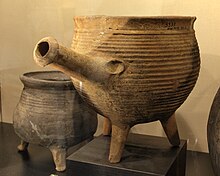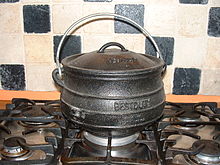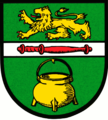Grapes
A Grapen (also Grape, Grappe, Grappen, Grope, Gropen, Groppe, Groppen) is a historical kitchen appliance ( cookware ) that was created in the 12th century .
Form and function
Grapen were initially earthen , later also bronze pots or kettles . They usually have the shape of a slightly squeezed ball with an outwardly sloping edge and three feet. Two handles allow it to be hung on a bracket. This means that grapes can also be hung on a height-adjustable kettle hook (Hal) over an open fireplace. There are also examples with only one handle known.
The round, bulbous shape and the three legs also make it possible to place the pot directly in the embers of the open fire of a hotplate. The relatively high mass of the pot distributes the heat to the inner surface and transfers it slowly and evenly to the food.
history
The grape emerged as an independent vessel shape in the 12th century. The older grapes were mostly made of clay. The bronze grapes were cast in a lost mold using a wax model . In the 13th century, foundries used two-part molds that could be used multiple times. From the 18th century, the importance of grapes in the kitchen quickly declined: The use of cheaper metals, especially cast iron , and above all the development of the closed kitchen stove , led to new pot shapes. Only in the country, tripod pots and in southern Denmark and northern Schleswig-Holstein ceramic Jydepötte survived until the middle of the 19th century.
Similar pots are known under the name Dutch oven (USA) or Camp Oven (Australia) or Potjie (South Africa and Namibia) and were introduced there by European settlers. These variants always have a lid.
To the present day, such vessels are made and used in West Africa. While the shape is very similar to the old European forms, the metal foundries in West Africa use aluminum.
heraldry
The grape - marmite (French), three-legged pot (English) - rarely the grape, has also found its way into heraldry as a common figure . The Grapen is particularly widespread in the coats of arms of the Brandenburg, Pomeranian and East Prussian heraldry. The stem of the word can also be used as a coat of arms for talking coats of arms : for example in the coat of arms of the Pomeranian family von Grape , for family names such as Grapengießer and Grappendorf, as well as in the coat of arms of the North Hessian noble family of the bullhead von Gudenberg .
literature
- Dieter Seyer: fire - stove - oven. A museum didactic teaching unit on the history of fire use, warming and food preparation (= teaching in Westphalian museums , volume 17). Landesbildstelle Westfalen - Department for Museum Education, Münster 1985, ISBN 3-923432-19-4 .
- Hans Drescher: Medieval three-legged pots made of bronze. Report on the inventory and attempt at a chronological order. In: New excavations and research in Lower Saxony , Volume 4, 1969, pp. 287-315, ISSN 0548-2682 .
Web links
- Page with text and picture of the Puchberg Castle Association (click on the photo of the 2 Grapen)
- Grapen - 360-degree view in the Virtual State Museum Mecklenburg
Individual evidence
- ^ Ernst Grohne : Bremen soil and excavator finds. In: Annual journal of the Focke Museum in Bremen. 1929, pp. 44-102, here p. 49, ZDB -ID 505041-8 .
- ↑ Rüdiger Articus: Jydepötte, Suurpötte, Taterntöpf (= Helms Museum, Hamburg Museum for Pre- and Early History. Information sheet . No. 44 ). Helms-Museum, Hamburg Museum of Prehistory and Early History, April 1980, ZDB -ID 1254498-X .
- ↑ Gisela Völger, Heiko Steuer: Central European three-legged pots as a model for African ceramics . In: Journal of Archeology of the Middle Ages . tape 13 , no. 1 , p. 193-198 .
- ↑ Gert Oswald : Lexicon of Heraldry. VEB Bibliographisches Institut, Leipzig 1984.







